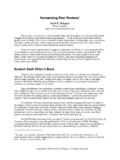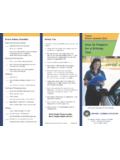Transcription of Karl Wiegers Describes 10 Requirements Traps to Avoid
1 Copyright 2000 by karl E. WiegersKarl Wiegers Describes 10 Requirements Traps to Avoid1 karl E. WiegersProcess path to quality software begins with excellent Requirements . Slighting the processes ofrequirements development and management is a common cause of software project frustrationand failure. This article Describes ten common Traps that software projects can encounter if teammembers and customers don t take Requirements seriously. I describe several symptoms that mightindicate when you re falling victim to each trap, and I offer several solutions to control aware, though, that none of these solutions will work if you re dealing withunreasonable people who are convinced that writing Requirements is time-wasting bureaucraticoverhead. To persuade such skeptics, present data such as that from the Standish Group sCHAOS report ( ~beau/ ) a study of 8,380IT projects which found that more than half were challenged, with reduced functionality beingdelivered over-budget and beyond the estimated schedule.
2 The top three contributing factors onchallenged projects were lack of user input ( of projects), incomplete Requirements andspecifications ( ), and changing Requirements and specifications ( ).Trap #1: Confusion Over Requirements Symptoms: Even the simple word Requirements means different things to different people. Anexecutive s notion of Requirements might be a high-level product concept or business vision,while a developer s Requirements might look suspiciously like detailed user interface Requirements often are really solution ideas. One symptom of potentialproblems is that project stakeholders refer to the Requirements with no qualifying project participants therefore will likely have different expectations of how much detail toexpect in the symptom is that the users provide the Requirements , but developers still aren tsure what they re supposed to build.
3 If Requirements discussions focus exclusively onfunctionality, the participants might not understand the various kinds of information that fall underthe broad rubric of Requirements . As a consequence, important stakeholder expectations mightgo unstated and : The first step is to recognize that there are several types of Requirements , all legitimateand all necessary. A second step is to educate all project participants about key requirementsengineering concepts, terminology, and think in terms of three levels of Requirements , all of which must be addressed duringrequirements development (Figure 1). At the top are the business Requirements , representing thehigh-level objectives of the organization or customer requesting the system or product. They 1 This paper was originally published in Software Testing & Quality Engineering, January/February 2000.
4 It isreprinted (with modifications) with permission from Software Quality Requirements Traps to AvoidPage 2 Copyright 2000 by karl E. Wiegersdescribe how the world will be better if the new product is in it. You can record businessrequirements in a product vision and scope second level addresses the user Requirements , which describe the tasks that usersmust be able to perform using the new product. These are best captured in the form of use cases,which are stories or scenarios of typical interactions between the user and the system. However,the use cases alone often don t provide enough detail for developers to know just what to , you should derive specific software functional Requirements the third requirementslevel from the use cases. The functional Requirements itemize the specific behaviors the softwaremust software Requirements specification (SRS) serves as a container for both thefunctional Requirements and the nonfunctional Requirements .
5 The latter include quality attributegoals, performance objectives, business rules, design and implementation constraints, and externalinterface Requirements . Quality attributes (such as usability, efficiency, portability, andmaintainability) need to be elicited from users, along with the use cases. (Suggested templates forthe SRS, the vision and scope document, and use cases are available ).Figure 1. Three Levels of Software RequirementsBusinessRequirementsUserRequ irementsFunctionalRequirementsQualityAtt ributesOther NonfunctionalRequirementsVision and ScopeDocumentUse CasesSoftware RequirementsSpecification (SRS)Trap #2: Inadequate Customer InvolvementSymptoms: Despite considerable evidence that it doesn t work, many projects seem to rely ontelepathy as the mechanism for communicating Requirements from users to developers.
6 Userssometimes believe that the developers should already know what users need, or that technical10 Requirements Traps to AvoidPage 3 Copyright 2000 by karl E. Wiegersstuff like Requirements development doesn t apply to users. Often, users claim to be too busy tospend the time it takes to iteratively gather and refine the Requirements . (Isn t it funny how wenever have time to do things right, but somehow we always find the time to do them over?)One indication of inadequate customer involvement is that user surrogates (such as usermanagers, marketing staff, or software developers) supply all of the input to clue is that developers have to make many Requirements decisions without adequateinformation and perspective. If you ve overlooked or neglected to gather input from some of theproduct s likely user classes, someone will be unhappy with the delivered product.
7 On one projectI know of, the customers rejected the product as unacceptable the first time they saw it, whichwas at its initial rollout. This is a strong but late and painful indication of inadequate customerinvolvement in Requirements : Begin by identifying your various user classes. User classes are groups of users whodiffer in their frequency of using the product, the features they use, their access privilege level, orin other ways. (See User-Driven Design by Donald Gause and Brian Lawrence in STQE,January/February 1999, for an excellent discussion of user classes.)An effective technique is to identify individual product champions to represent specificuser classes. Product champions collect input from other members of their user class, supply theuser Requirements , and provide input on quality attributes and requirement approach is particularly valuable when developing systems for internal corporate use;for commercial product development it might be easier to convene focus groups of representativeusers.
8 Focus group participants can provide a broad range of input on desired product featuresand characteristics. The individuals you select as user representatives can also evaluate anyprototypes you create, and review the SRS for completeness and accuracy. Strive to build acollaborative relationship between your customer representatives and the development #3: Vague and Ambiguous RequirementsSymptoms: Ambiguity is the great bugaboo of software Requirements . You ve encounteredambiguity if a requirement statement can have several different meanings and you re not surewhich is correct. A more insidious form of ambiguity results when multiple readers interpret arequirement in different ways. Each reader concludes that his or her interpretation is correct, andthe ambiguity remains undetected until later when it s more expensive to hint that your Requirements are vague or incomplete is that the SRS is missinginformation the developers need.
9 If you can t think of test cases to verify whether eachrequirement was properly implemented, your Requirements are not sufficiently well might assume that whatever they ve been given in the form of Requirements is adefinitive and complete product description, but this is a risky ultimate symptom of vague Requirements is that developers have to ask the analyst orcustomers many questions, or they have to guess about what is really intended. The extent of thisguessing game might not be recognized until the project is far along and implementation hasdiverged from what is really required. At this point, expensive rework may be needed to bringthings back into : Avoid using intrinsically subjective and ambiguous words when you writerequirements. Terms like minimize, maximize, optimize, rapid, user-friendly, easy, simple, often,normal, usual, large, intuitive, robust, state-of-the-art, improved, efficient, and flexible areparticularly dangerous.
10 Avoid and/or and etc. like the plague. Requirements that include the10 Requirements Traps to AvoidPage 4 Copyright 2000 by karl E. Wiegersword support are not verifiable; define just what the software must do to support s fine to include TBD (to be determined) markers in your SRS to indicate currentuncertainties, but make sure you resolve them before proceeding with design and ferret out ambiguity, have a team that represents diverse perspectives formally inspectthe Requirements documents. Suitable inspectors include: the analyst who wrote the Requirements the customer or marketing representative who supplied them (particularly for use casereviews) a developer who must implement them a tester who must verify themAnother powerful technique is to begin writing test cases early in requirementsdevelopment.









